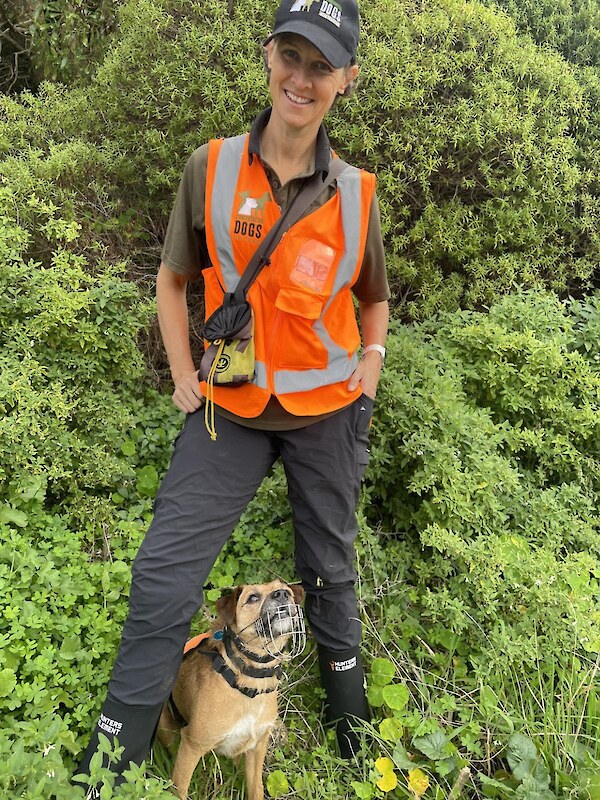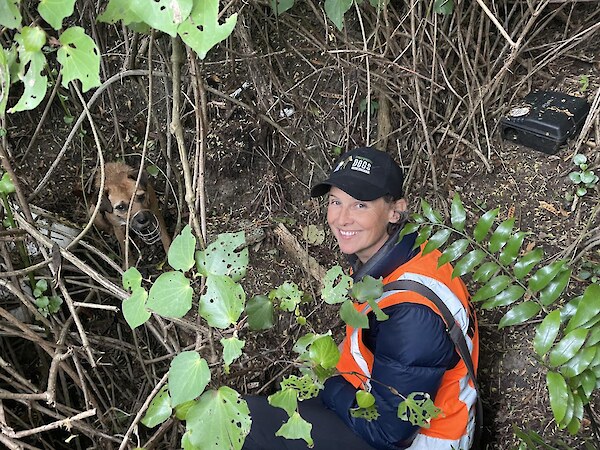Rapu the wonder dog smells a rat
This article was part of an eight-week guest column in The Post by our Board Chair and former Post editor Tim Pankhurst, published on 15 June 2024. See original article here.
Rapu smells a rat. Wellington Predator Free detector dog Rapu and trainer Sally Bain. Photo courtesy The Post
Wellington Predator Free detector dog Rapu and trainer Sally Bain. Photo courtesy The Post
His shoulders tense and his tail wags as he moves into hunting mode. He has tracked an intruder rat on the steep steps above the Scorch O Rama Café at Scorching Bay and is keenly interested in an adjacent tangle of Cape ivy.
His trainer Sally Bain lifts Rapu over the steps fence and he scoots a few metres across the steep bank and promptly sits down, staring intently into the thicket.
His communication could not be plainer – this is where the rat is.
It was spotted on a camera sited next to a bait station and the cavalry in the form of Rapu and Sally called in. Miramar Peninsula was declared predator free last December and phase two of pest eradication – rats, stoats and weasels – from Island Bay to the CBD is now well advanced. But the ground won has to be guarded.
Cape ivy (Senecio angulatus), introduced as an ornamental shrub from South Africa, has become a widespread invasive weed that is ideal habitat for rats. It is warm, safe, its dense stalks a defense from cats and dogs and is full of insects.
The rat Rapu is so interested in amongst the ivy may be already dead from poison but the Predator Free Wellington (PFW) team moves in to heavily target the area until there is no further detection.
Rapu is technically a mongrel as a border cross parson terrier but has an impressive pedigree nevertheless. His border mother is a rodent dog with the Department of Conservation (DOC) in the Coromandel and parson terrier father is a wallaby detector in Tauranga.
“Training terriers is hard work,” Bain says. “The hardest part is teaching them not to go for anything else – a weka, a cat, a penguin, a kiwi, lizard.”
The training to pass interim and full certification overseen by DOC takes about two years. It includes compulsory wearing of a muzzle around protected species – just in case. Bain says the DOC-supervised training is vital.
“There are groups using dogs that are not certified and that undermines us and could go wrong. It can be dangerous work for a dog and is a 24/7 activity. I don’t get to go for relaxing weekend walks anymore,” Bain says.
She also has an apprentice detector dog, a fox terrier named Kimi, that has just passed interim certification.
Although her mission is to locate and kill rats, Bain has a sneaking admiration for these intelligent rodents. She has even had them as pets, fascinated by their behaviour and habits. She now settles for the dogs and a free ranging guinea pig. Wellington Predator Free detector dog Rapu and trainer Sally Bain. Photo courtesy The Post
Wellington Predator Free detector dog Rapu and trainer Sally Bain. Photo courtesy The Post
“I like rats. They have evolved with humans, they have been with us for a long time. They are clever and adaptable. I find them fascinating – the way they move, the way they live, the way they interact with humans.”
A favourite rat food is faeces, human and animal. A large rat nest was found at Evans Bay adjacent to the boat sewage discharging terminal and discarded doggie pooh bags have been found in rat nests – another reason to take dog droppings home with you and dispose properly.
Bain is tall and lean, fast striding with a ready sunny smile.
“I love scrambling around on cliffs like a little kid,” she says. “This is where I’m meant to be. I didn’t expect to be this fit at 50. It’s good for quality of life.”
She grew up at Point Howard at Eastbourne and when she returned home after 13 years away that included establishing a ski chalet business in a French alpine village and managing hunting estates in England, was struck by the flowering rata on the ridgeline above Butterfly Creek.
She had never seen the crimson rata when growing up due to the depredations of possums.
A concerted trapping and baiting campaign took care of them and the bush recovered.
That spurred her to get involved in voluntary trapping and it became a fulltime occupation. She then set up her dog detector business, Kuri Tiaki Ltd, which contracts to Predator Free Wellington through the Wellington Regional Council.
Back on the trail of the Scorching Bay intruder, Bain asks permission to enter a property adjacent to the tangled shrubbery. An app on her phone has contact details and also warns of any unfriendly dogs.
There is a cat sitting on a fence rail who arches his back as Rapu goes by but he is not distracted.
We circle back to the café carpark where Rapu whines around a rubbish bin and stands on his hind legs peering into the rim.
“This is likely where the rat came from,” Bain says. “It probably came in a car and hopped out when they parked. We don’t know yet how many rodents might come in cars in winter. It’s all about limiting the incursion.”
Posted: 15 June 2024
